《经济学人》2014年1月-美国经济
- 格式:doc
- 大小:111.50 KB
- 文档页数:6
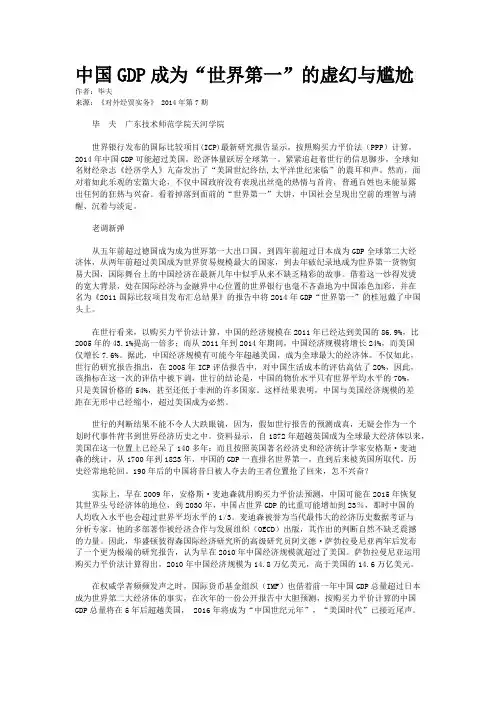
中国GDP成为“世界第一”的虚幻与尴尬作者:毕夫来源:《对外经贸实务》 2014年第7期毕夫广东技术师范学院天河学院世界银行发布的国际比较项目(ICP)最新研究报告显示,按照购买力平价法(PPP)计算,2014年中国GDP可能超过美国,经济体量跃居全球第一。
紧紧追赶着世行的信息脚步,全球知名财经杂志《经济学人》亢奋发出了“美国世纪终结,太平洋世纪来临”的震耳和声。
然而,面对着如此乐观的宏篇大论,不仅中国政府没有表现出丝毫的热情与首肯,普通百姓也未能显露出任何的狂热与兴奋。
看着掉落到面前的“世界第一”大饼,中国社会呈现出空前的理智与清醒、沉着与淡定。
老调新弹从五年前超过德国成为成为世界第一大出口国,到四年前超过日本成为GDP全球第二大经济体,从两年前超过美国成为世界贸易规模最大的国家,到去年破纪录地成为世界第一货物贸易大国,国际舞台上的中国经济在最新几年中似乎从来不缺乏精彩的故事。
借着这一炒得发烫的宽大背景,处在国际经济与金融界中心位置的世界银行也毫不吝啬地为中国添色加彩,并在名为《2011国际比较项目发布汇总结果》的报告中将2014年GDP“世界第一”的桂冠戴了中国头上。
在世行看来,以购买力平价法计算,中国的经济规模在2011年已经达到美国的86.9%,比2005年的43.1%提高一倍多;而从2011年到2014年期间,中国经济规模将增长24%,而美国仅增长7.6%。
据此,中国经济规模有可能今年超越美国,成为全球最大的经济体。
不仅如此,世行的研究报告指出,在2005年ICP评估报告中,对中国生活成本的评估高估了20%,因此,该指标在这一次的评估中被下调,世行的结论是,中国的物价水平只有世界平均水平的70%,只是美国价格的54%,甚至还低于非洲的许多国家。
这样结果表明,中国与美国经济规模的差距在无形中已经缩小,超过美国成为必然。
世行的判断结果不能不令人大跌眼镜,因为,假如世行报告的预测成真,无疑会作为一个划时代事件背书到世界经济历史之中。
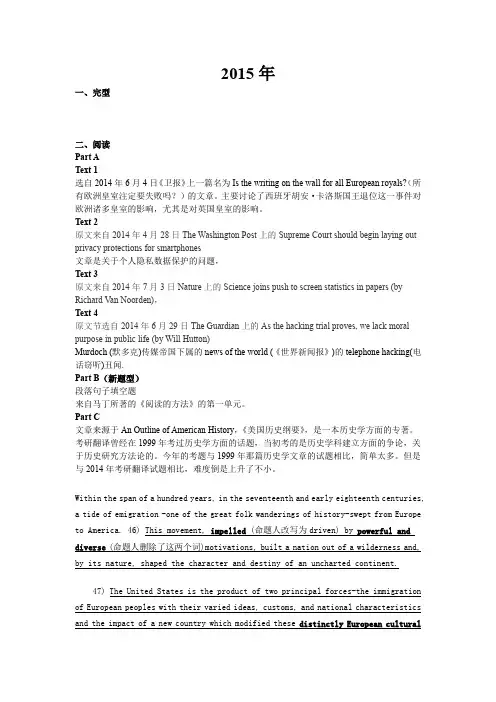
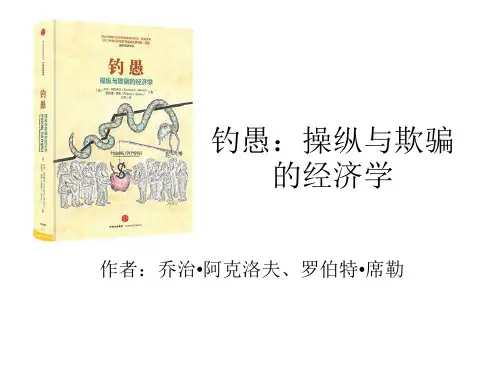
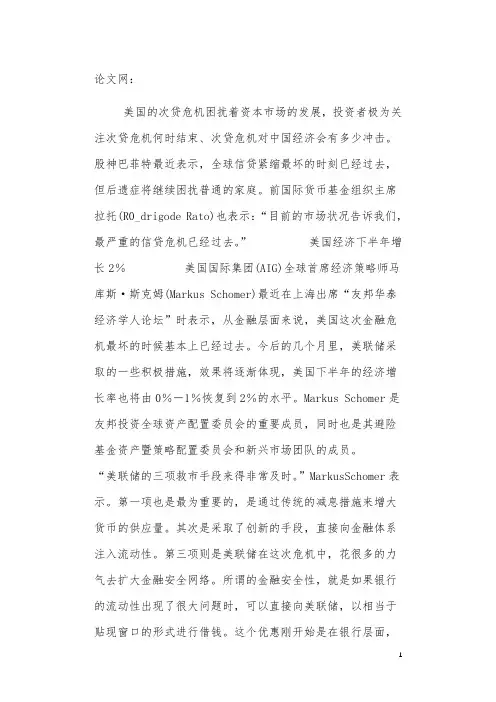
论文网:美国的次贷危机困扰着资本市场的发展,投资者极为关注次贷危机何时结束、次贷危机对中国经济会有多少冲击。
股神巴菲特最近表示,全球信贷紧缩最坏的时刻已经过去,但后遗症将继续困扰普通的家庭。
前国际货币基金组织主席拉托(R0_drigode Rato)也表示:“目前的市场状况告诉我们,最严重的信贷危机已经过去。
”美国经济下半年增长2%美国国际集团(AIG)全球首席经济策略师马库斯·斯克姆(Markus Schomer)最近在上海出席“友邦华泰经济学人论坛”时表示,从金融层面来说,美国这次金融危机最坏的时候基本上已经过去。
今后的几个月里,美联储采取的一些积极措施,效果将逐渐体现,美国下半年的经济增长率也将由0%-1%恢复到2%的水平。
Markus Schomer是友邦投资全球资产配置委员会的重要成员,同时也是其避险基金资产暨策略配置委员会和新兴市场团队的成员。
“美联储的三项救市手段来得非常及时。
”MarkusSchomer表示。
第一项也是最为重要的,是通过传统的减息措施来增大货币的供应量。
其次是采取了创新的手段,直接向金融体系注入流动性。
第三项则是美联储在这次危机中,花很多的力气去扩大金融安全网络。
所谓的金融安全性,就是如果银行的流动性出现了很大问题时,可以直接向美联储,以相当于贴现窗口的形式进行借钱。
这个优惠刚开始是在银行层面,现在也向一些主要的券商进行开放。
通过一系列的稳定市场的措施,MarkusSchomer认为,美国的房屋市场虽然目前仍在继续下探的过程中,但预计下半年将会有所企稳。
因为,从统计数据来看,美国对于房屋购买可支付能力的指数已经恢复到了这次危机爆发之前的水平。
“这也是我对下半年美国房屋市场企稳,保持相对乐观态度的主要原因”。
Markus Schomer说,这些综合的效果会逐渐显现出来,金融危机会随之逐渐好转。
在实体经济层面,虽然前期在通胀的压力之下,实际的消费支出是在下降,但在未来几个月之内,由于需求的减缓,通胀水平会得到一定的企稳和走软,加之现在住宅的销量在慢慢提升,进入7、8月份以后,通常是美国一个高消费的时期,所以将会使美国经济进入一个修复和强劲上升的阶段,一个见底回升的阶段。
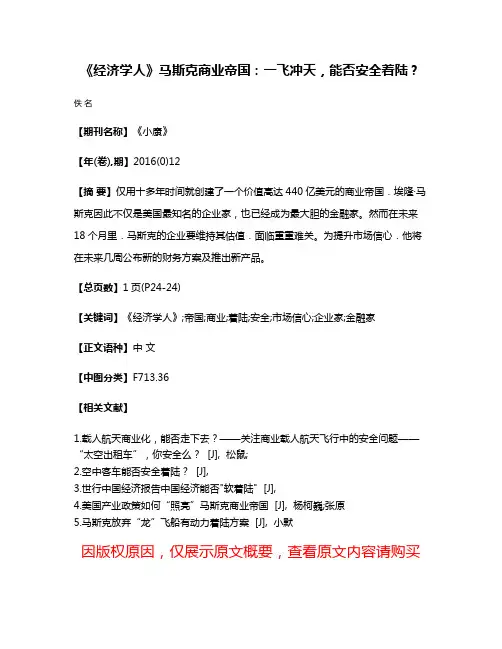
《经济学人》马斯克商业帝国:一飞冲天,能否安全着陆?佚名
【期刊名称】《小康》
【年(卷),期】2016(0)12
【摘要】仅用十多年时间就创建了一个价值高达440亿美元的商业帝国.埃隆·马斯克因此不仅是美国最知名的企业家,也已经成为最大胆的金融家。
然而在未来18个月里.马斯克的企业要维持其估值.面临重重难关。
为提升市场信心.他将在未来几周公布新的财务方案及推出新产品。
【总页数】1页(P24-24)
【关键词】《经济学人》;帝国;商业;着陆;安全;市场信心;企业家;金融家
【正文语种】中文
【中图分类】F713.36
【相关文献】
1.载人航天商业化,能否走下去?——关注商业载人航天飞行中的安全问题——“太空出租车”,你安全么? [J], 松鼠;
2.空中客车能否安全着陆? [J],
3.世行中国经济报告中国经济能否"软着陆" [J],
4.美国产业政策如何“照亮”马斯克商业帝国 [J], 杨柯巍;张原
5.马斯克放弃“龙”飞船有动力着陆方案 [J], 小默
因版权原因,仅展示原文概要,查看原文内容请购买。
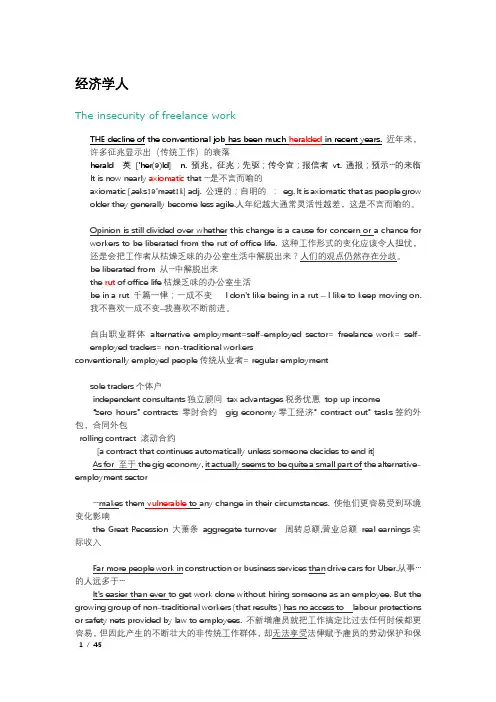
经济学人The insecurity of freelance workTHE decline of the conventional job has been much heralded in recent years.近年来,许多征兆显示出(传统工作)的衰落herald 英['her(ə)ld]n. 预兆,征兆;先驱;传令官;报信者vt. 通报;预示…的来临It is now nearly axiomatic that …是不言而喻的axiomatic[,æksɪə'mætɪk]adj. 公理的;自明的:eg. It is axiomatic that as people grow older they generally become less agile.人年纪越大通常灵活性越差,这是不言而喻的。
Opinion is still divided over whether this change is a cause for concern or a chance for workers to be liberated from the rut of office life.这种工作形式的变化应该令人担忧,还是会把工作者从枯燥乏味的办公室生活中解脱出来?人们的观点仍然存在分歧。
be liberated from 从…中解脱出来the rut of office life枯燥乏味的办公室生活be in a rut 千篇一律;一成不变I don't like being in a rut – I like to keep moving on.我不喜欢一成不变–我喜欢不断前进。
自由职业群体alternative employment=self-employed sector=freelance work=self-employed traders= non-traditional workersconventionally employed people传统从业者=regular employmentsole traders个体户independent consultants独立顾问tax advantages税务优惠top up income“zero hours” contracts 零时合约gig economy零工经济”contract out” tasks签约外包,合同外包rolling contract 滚动合约[a contract that continues automatically unless someone decides to end it]As for 至于the gig economy, it actually seems to be quite a small part of the alternative-employment sector…makes them vulnerable to any change in their circumstances.使他们更容易受到环境变化影响the Great Recession 大萧条aggregate turnover 周转总额,营业总额real earnings实际收入Far more people work in construction or business services than drive cars for Uber.从事…的人远多于…It’s easier than ever to get work done without hiring someone as an employee. But the growing group of non-traditional workers (that results ) has no access to labour protections or safety nets provided by law to employees. 不新增雇员就把工作搞定比过去任何时候都更容易,但因此产生的不断壮大的非传统工作群体,却无法享受法律赋予雇员的劳动保护和保障机制。
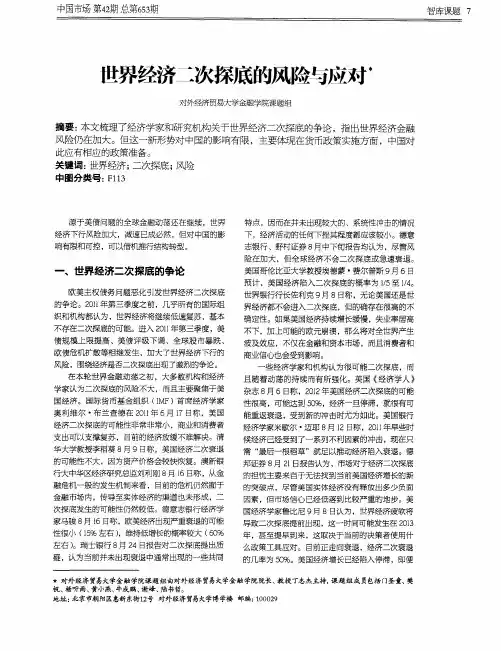
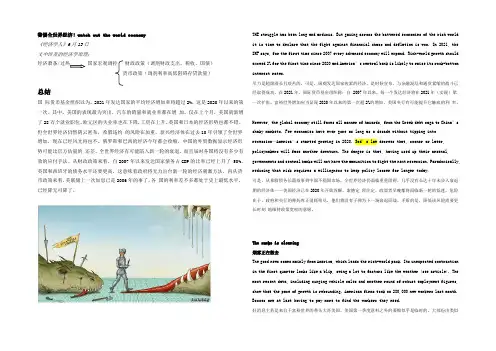
警惕全世界经济!watch out the world economy 《经济学人》6月13日文中涉及的经济学原理:经济萧条/国家宏观调控财政政策(调剂财政支出,税收、国债)货币政策(调剂利率高低阻碍存贷款量)总结国际货币基金组织以为,2021年发达国家的平均经济增加率将超过2%,这是2020年以来的第一次。
其中,美国的表现最为突出,汽车的销量和就业率都在增加。
仅在上个月,美国就新增了28万个就业职位。
欧元区的失业率也在下降,工资在上升。
英国和日本的经济形势也都不错。
但全世界经济仍然阴云密布,希腊违约的风险在加重,新兴经济体在过去10年引领了全世界增加,现在已经风光再也不。
俄罗斯和巴西的经济今年都会收缩,中国的外贸数据显示经济形势可能比官方估量的还差。
全世界经济有可能陷入新一轮的衰退,而且届时各国将没有多少有效的应付手法。
从财政政策来看,自2007年以来发达国家债务占GDP的比率已经上升了 50%,英国和西班牙的债务水平还要更高,这意味着政府将无力出台新一轮的经济刺激方法。
再从货币政策来看,美联储上一次加息已是2006年的事了,各国的利率差不多都处于史上最低水平,已经降无可降了。
THE struggle has been long and arduous. But gazing across the battered economies of the rich world it is time to declare that the fight against financial chaos and deflation is won. In 2021, the IMF says, for the first time since 2007 every advanced economy will expand. Rich-world growth should exceed 2% for the first time since 2020 and America’s central bank is likely to raise its rock-bottom interest rates.尽力是超级漫长且艰苦的。
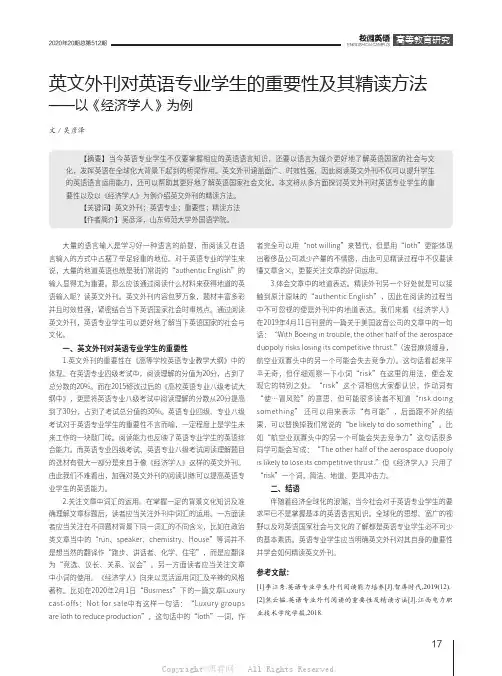
172020年20期总第512期ENGLISH ON CAMPUS英文外刊对英语专业学生的重要性及其精读方法——以《经济学人》为例文/吴彦泽【摘要】当今英语专业学生不仅要掌握相应的英语语言知识,还要以语言为媒介更好地了解英语国家的社会与文化,发挥英语在全球化大背景下起到的桥梁作用。
英文外刊涵盖面广、时效性强,因此阅读英文外刊不仅可以提升学生的英语语言运用能力,还可以帮助其更好地了解英语国家社会文化。
本文将从多方面探讨英文外刊对英语专业学生的重要性以及以《经济学人》为例介绍英文外刊的精读方法。
【关键词】英文外刊;英语专业;重要性;精读方法【作者简介】吴彦泽,山东师范大学外国语学院。
大量的语言输入是学习好一种语言的前提,而阅读又在语言输入的方式中占据了举足轻重的地位。
对于英语专业的学生来说,大量的地道英语也就是我们常说的“authentic English”的输入显得尤为重要。
那么应该通过阅读什么材料来获得地道的英语输入呢?读英文外刊。
英文外刊内容包罗万象,题材丰富多彩并且时效性强,紧密结合当下英语国家社会时事热点。
通过阅读英文外刊,英语专业学生可以更好地了解当下英语国家的社会与文化。
一、英文外刊对英语专业学生的重要性1.英文外刊的重要性在《高等学校英语专业教学大纲》中的体现。
在英语专业四级考试中,阅读理解的分值为20分,占到了总分数的20%。
而在2015修改过后的《高校英语专业八级考试大纲中》,更是将英语专业八级考试中阅读理解的分数从20分提高到了30分,占到了考试总分值的30%。
英语专业四级、专业八级考试对于英语专业学生的重要性不言而喻,一定程度上是学生未来工作的一块敲门砖。
阅读能力也反映了英语专业学生的英语综合能力。
而英语专业四级考试、英语专业八级考试阅读理解题目的选材有很大一部分是来自于像《经济学人》这样的英文外刊。
由此我们不难看出,加强对英文外刊的阅读训练可以提高英语专业学生的英语能力。
2.关注文章中词汇的运用。
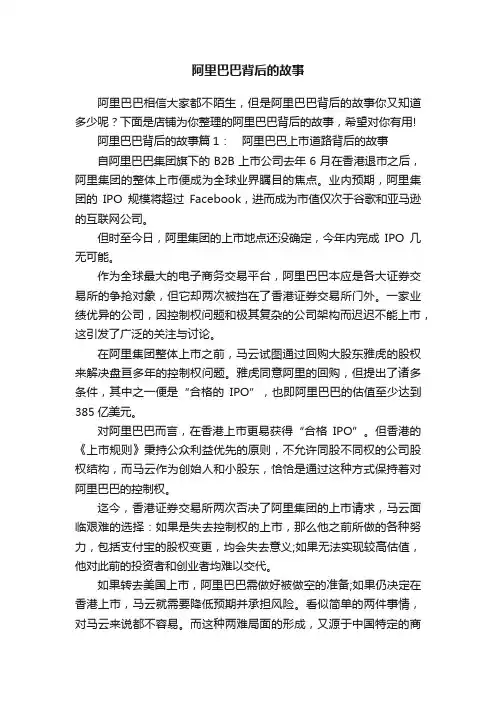
阿里巴巴背后的故事阿里巴巴相信大家都不陌生,但是阿里巴巴背后的故事你又知道多少呢?下面是店铺为你整理的阿里巴巴背后的故事,希望对你有用!阿里巴巴背后的故事篇1:阿里巴巴上市道路背后的故事自阿里巴巴集团旗下的B2B上市公司去年6月在香港退市之后,阿里集团的整体上市便成为全球业界瞩目的焦点。
业内预期,阿里集团的IPO规模将超过Facebook,进而成为市值仅次于谷歌和亚马逊的互联网公司。
但时至今日,阿里集团的上市地点还没确定,今年内完成IPO几无可能。
作为全球最大的电子商务交易平台,阿里巴巴本应是各大证券交易所的争抢对象,但它却两次被挡在了香港证券交易所门外。
一家业绩优异的公司,因控制权问题和极其复杂的公司架构而迟迟不能上市,这引发了广泛的关注与讨论。
在阿里集团整体上市之前,马云试图通过回购大股东雅虎的股权来解决盘亘多年的控制权问题。
雅虎同意阿里的回购,但提出了诸多条件,其中之一便是“合格的IPO”,也即阿里巴巴的估值至少达到385亿美元。
对阿里巴巴而言,在香港上市更易获得“合格IPO”。
但香港的《上市规则》秉持公众利益优先的原则,不允许同股不同权的公司股权结构,而马云作为创始人和小股东,恰恰是通过这种方式保持着对阿里巴巴的控制权。
迄今,香港证券交易所两次否决了阿里集团的上市请求,马云面临艰难的选择:如果是失去控制权的上市,那么他之前所做的各种努力,包括支付宝的股权变更,均会失去意义;如果无法实现较高估值,他对此前的投资者和创业者均难以交代。
如果转去美国上市,阿里巴巴需做好被做空的准备;如果仍决定在香港上市,马云就需要降低预期并承担风险。
看似简单的两件事情,对马云来说都不容易。
而这种两难局面的形成,又源于中国特定的商业环境。
如何让企业不再扭曲生存,值得各方深思。
阿里巴巴的上市计划又延后了。
10月10日下午,阿里巴巴集团CEO陆兆禧在一次媒体交流活动上表示,香港市场对新兴企业的治理结构创新,还需要时间研究和消化,阿里巴巴决定不在香港上市。
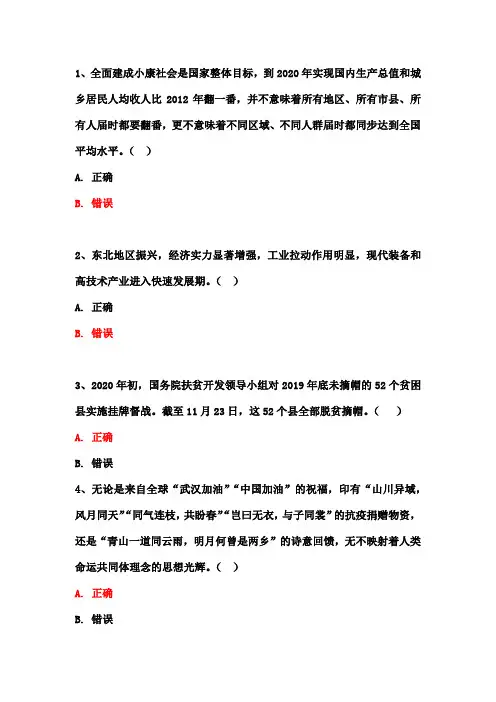
1、全面建成小康社会是国家整体目标,到2020年实现国内生产总值和城乡居民人均收人比2012年翻一番,并不意味着所有地区、所有市县、所有人届时都要翻番,更不意味着不同区域、不同人群届时都同步达到全国平均水平。
()A. 正确B. 错误2、东北地区振兴,经济实力显著增强,工业拉动作用明显,现代装备和高技术产业进入快速发展期。
()A. 正确B. 错误3、2020年初,国务院扶贫开发领导小组对2019年底未摘帽的52个贫困县实施挂牌督战。
截至11月23日,这52个县全部脱贫摘帽。
()A. 正确B. 错误4、无论是来自全球“武汉加油”“中国加油”的祝福,印有“山川异域,风月同天”“同气连枝,共盼春”“岂曰无衣,与子同裳”的抗疫捐赠物资,还是“青山一道同云雨,明月何曾是两乡”的诗意回馈,无不映射着人类命运共同体理念的思想光辉。
()A. 正确B. 错误5、2017年11月1日,“构建人类命运共同体”还写入了联大“防止外空军备竞赛进一步切实措施”和“不首先在外空建立殖民地”两份安全决议。
()A. 正确B. 错误6、古罗马哲学家塞涅卡曾说:人人为我,我为人人。
()A. 正确B. 错误7、在区域层面,习近平主席在多个方向上提出构建命运共同体:在亚太方向,连续多年在亚太经合组织工商领导人峰会上,倡导树立“亚太命运共同体意识”;在周边方向,提出要“让命运共同体意识在周边国家落地生根”。
A. 正确B. 错误8、虽然因为疫情防控工作的影响,2020年第一季度同比下降6.8%;但随着复工复查的紧锣密鼓的开展,第二季度增长3.2%,第三季度更是增长达4.9%。
成为全球唯一实现经济正增长的国家。
()A. 正确B. 错误9、中国率先控制疫情,恢复经济和社会秩序,是对全球抗疫的最大支持。
作为“世界工厂”,中国率先复工复产,极大缓解了全球医疗物资的供应紧张,也有助于推动世界经济早日重回正常发展轨道。
()A. 正确B. 错误10、只有牢牢把握“三条底线”,即绝不能允许任何危害国家主权安全、挑战中央权力和基本法权威、利用特别行政区对内地进行渗透破坏的活动。
Immigration law移民法Our town我们的城镇A small city passes a controversial immigration ordinance內布拉斯加小镇通过了一项有争议的移民法令SOME of the earliest settlers of Nebraska were Germans. During the first world war the state forbade any teaching in their native language. But that was long ago. These days, just outside the tidy little city of Fremont, a new batch of residents is trying to settle in. The Regency II trailer park houses immigrants, mostly from Mexico. Many of the trailers are just flimsy boxes. Others are painted brightly, or sport day lilies on a small lawn. One house has an American flag beside it. And on June 21st the Regency displayed a white sign at its entrance with the message: “V ote No”.内布拉斯加州最早的定居者中有一些是德国人。
在第一次世界大战期间,该州曾禁止德裔居民用母语教学。
但这是很久以前的事了。
这些天来,就在整洁的弗里蒙特小镇外围,一批新的居民正试着安顿新家。
Regency II拖车场的居民都是移民,多数来自墨西哥。
(2):食品公司与减肥斗士【翻译交流】Feb 9th 2006From The Economist Global AgendaFood firms and fat-fighters食品公司与减肥斗士Five leading food companies have introduced a labelling scheme for their products in the British market, in an attempt to assuage critics who say they encourage obesity. But consumer groups are unhappy all the same. Is the food industry, like tobacco before it, about to be *engulfed[1]by a wave of lawsuits brought on health grounds?五家业内领先的食品公司采取了一项方案,就是在其投入英国市场的食品上作出标注,力图堵住那些说他们鼓励肥胖的批评人士的嘴。
不过,消费者团体仍然不开心。
食品业会像之前的烟草一样,被卷入一场关乎健康的诉讼之中吗?KEEPING fit requires a combination of healthy eating and regular exercise. On the second of these at least, the world’s food companies can claim to be setting a good example :they have been working up quite a sweat in their attempts to fend off assaults by governments, consumer groups and lawyers who accuse them of peddling products that encourage obesity. This week saw the unveiling of another industry initiative :five leading food producers—Danone, Kellogg, Nestlé, Kraft and PepsiCo—introduced a labelling scheme for the British market which will show “guideline daily amounts” for calories, fats, sugar and salt on packaging. The new labels will start to appear on the firms’ crisps, chocolate bars, cheese slices *and the like[2] over the next few months. A number of other food giants, such as Cadbury Schweppes and Masterfoods, have already started putting guideline labels on their products.将健康的饮食习惯和经常性的锻炼二者结合才可以让身体保持健康。
The truth hurts 真相伤人Mar 31st 2010 | WASHINGTON, DC | From The Economist print editionWill the Treasury call China a currency manipulator?财政部会定义中国为货币操纵国吗?TO MOST people, to say that China holds down the value of its currency to boost its exports is to state the obvious. Not, though, to America’s Treasury Department. By law it must report twice a year on which countries fiddle their exchange rates at the world’s expense. China was last fingered in 1994. Ever since then, the Treasury has concluded that the designation would do more harm than good. Speculation is growing that it may decide differently in its next report, due on April 15th.对大多数人来说,说中国通过抑制人民币的价值,刺激出口,等于在陈述一个明显的事实。
然而对美国财政部来说,却不是这么简单。
法律规定它每隔两年对其它国家干涉汇率,危害他国的行为进行汇报。
中国曾在1994年列入汇率操纵国。
自那时候起,财政部得出结论:罗列中国,更多的是带来坏处。
外界猜测财政部可能将在4月15日的报告中推翻原先的结论。
The mood in America resembles that in 2005, when the Senate voted to hit China with tariffs of 27.5% and the Treasury ratcheted up its rhetoric. China abruptly moved to a managed float for the yuan. It was allowed to appreciate by 20% over the next three years before a halt was called during the banking panic of 2008.现在美国的感受类似2005年。
中美两国宏观经济指数对比一、中国宏观经济主要指数体系1.指标体系主要构架2.主要关注指标(1)GDPGDP是最受关注的宏观经济统计数据,是衡量国民经济发展情况的重要指标。
GDP增速越快表明经济发展越快,增速越慢表明经济发展越慢,GDP负增长表明经济陷入衰退。
(2)社会消费品零售总额社会消费品零售总额反映国内消费支出情况,对判断国民经济现状和前景具有重要的指导作用。
社会消费品零售总额提升,表明消费支出增加,经济情况较好;社会消费品零售总额下降,表明经济景气趋缓或不佳。
(3)进出口额对外贸易占中国GDP比重达到60%以上,对中国经济影响巨大。
欧美日经济危机持续时间越长,对中国实体经济出口量的冲击越大。
(4)城镇固定资产投资作为拉动经济发展的三驾马车,在消费、出口受经济危机影响较大的情况下,加大投资成为重要的政策选择。
(4)CPI,PPICPI是反映与居民生活有关的产品及劳务价格变动的综合指标,通常作为观察通货膨胀或紧缩的重要指标。
与货币供应量等其他指标数据相结合,能够更准确的判断通货膨胀或紧缩状况。
PPI主要用于衡量各种商品在不同生产阶段的价格变化情况,与CPI一样,是观察通货膨胀或紧缩的重要指标。
一般认为,PPI对CPI 具有一定的传导作用。
(6)原材料、燃料和动力购进价格指数原材料、燃料和动力购进价格指数反映工业企业从物资交易市场和能源、原材料生产企业购买原材料、燃料和动力产品时所支付价格水平的变动趋势和程度。
该指标对PPI具有一定的传导作用。
(5)货币供应量余额宏观经济出现较大波动时,货币供应量的变化备受关注。
利率体现了信用关系中,债务人支付给债权人的资金借用报酬。
利率的变化,直接反映出市场中资金供求关系的变化。
在市场繁荣之时,资金供不应求,利率上升;市场疲软之时,资金供过于求,利率下降。
从另一个角度看,利率上升,抑制资金需求,经济发展降温;利率下降,刺激资金需求,经济发展回暖。
利率的变化反作用于资金供求,从而作用于经济发展,因此成为一项重要的货币政策工具。
2014年1月《经济学人》 英文原文:
The $9 trillion sale Governments should launch a new wave of privatisations, this time centred on property
Jan 11th 2014 | From the print edition
Tweet
IMAGINE you were heavily in debt, owned a large portfolio of equities and under-used property and were having trouble cutting your spending—much like most Western governments. Wouldn’t you think of offloading some of your assets?
Politicians push privatisation at different times for different reasons. In Britain in the 1980s, Margaret Thatcher used it to curb the power of the unions. Eastern European countries employed it later to dismantle command economies. Today, with public indebtedness at its highest peacetime level in advanced economies, the main rationale is to raise cash.
In this section The $9 trillion sale Can François do a Gerhard?
Of bongs and bureaucrats
It’s back
An Englishman’s home
Reprints Related topics Europe
Greece
Organisation for Economic Cooperation and Development
Sweden
United Kingdom
Taxpayers might think that the best family silver has already been sold, but plenty is still in the cupboard (see article). State-owned enterprises in OECD countries are worth around $2 trillion. Then there are minority stakes in companies, plus $2 trillion or so in utilities and other assets held by local governments. But the real treasures are “non-financial” assets—buildings, land, subsoil resources—which the IMF believes are worth three-quarters of GDP on average in rich economies: $35 trillion across the OECD.
Some of these assets could not or should not be sold. What price the Louvre, the Parthenon or Yellowstone National Park? Murky government accounting makes it impossible to know what portion of the total such treasures make up. But it is clear that the overall list includes thousands of marketable holdings with little or no heritage value.
America’s federal government owns nearly 1m buildings (of which 45,000 were found to be unneeded or under-used in a 2011 audit) and about a fifth of the country’s land area, beneath which lie vast reserves of oil, gas and other minerals; America’s “fracking” revolution has so far been almost entirely on private land. The Greek state’s largest stock of unrealised value lies in its more than 80,000 non-heritage buildings and plots of land. With only one holiday home for every 100 in Spain, Greece should be able to tempt developers and other investors at the right price. Analysts at PwC reckon Sweden has marketable state-owned property worth $100 billion-120 billion. If that is typical of the OECD, its governments are sitting on saleable land and buildings worth up to $9 trillion—equivalent to almost a fifth of their combined gross debt.
Get on with it Governments seem strangely reluctant to exploit these revenue-raising opportunities. That is partly because privatisation always faces opposition. Particular sensitivities surround land, as Ronald Reagan discovered when his plan to sell swathes of America’s West were shot down by a coalition of greens and ranchers who enjoyed grazing rights, and as the British government found in 2010 when environmentalists scuppered its attempt to sell Forestry Commission land.
In recent years the big transactions, apart from reprivatisations of rescued banks, have mostly taken place in emerging markets. Activity is starting to pick up in Europe: the British government sold Royal Mail last year, and is setting a good example both in transparency over its land and property holdings and in its readiness to sell them. But, overall, caution rules. Italy, for example, carries a public-debt burden of 132% of GDP, yet its privatisation plans are timid—even though the state has proportionately more to sell than most other rich countries, with corporate stakes worth perhaps $225 billion and non-financial assets worth as much as $1.6 trillion. Now that markets have regained their composure, it is time to be bolder.
There are ways of encouraging sales. Data collection on public property is shockingly poor. It is patchy even in Scandinavia, where governments pride themselves on their openness. Governments need to get a better idea of what they hold. Effective land registries, giving certainty to title, are essential: Greece’s registry remains a mess. Too many governments use a flaky form of “cash basis” accounting that obscures the costs of holding property. Too few produce proper balance-sheets. Better beancounting would make it easier to ascertain what might be better off in private hands.